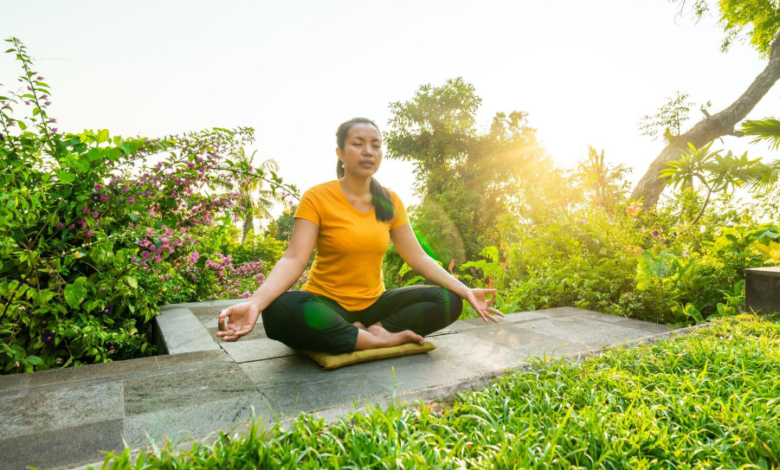Online Meditation Course or In‑Person in Malaysia Centers?

You can practice mindfulness easily, whether at home or in a retreat. Choosing a meditation course online or attending one in person at Malaysian centers depends on your lifestyle, goals, and learning preferences. Online courses let you learn at your own pace, while in-person classes give you direct help and a supportive group. Both help you improve focus, find peace, and grow personally.
The Importance of Environment in Meditation
A calm and comfortable meditation space helps you relax and concentrate better. Choose a quiet, tidy space with calming elements and no distractions.
- Fewer Distractions = Better Focus
Having fewer distractions means better focus. A quiet and tidy space helps calm your mind, so you can concentrate more easily.
- Helps You Relax Emotionally
Soft lighting, calm colors, and natural items like plants or stones help reduce stress and create a peaceful feeling.
- Connects You with Nature
Bringing nature into your space (like plants or nature sounds) calms the mind and builds a deeper connection to the world around you.
- Builds a Helpful Habit
Using the same spot every time trains your brain to shift into “meditation mode” faster.
- Improves Your Overall Well-Being
Meditating in a relaxing space can lower stress and even encourage eco-friendly habits and awareness.
A calm and natural space helps you relax, stay focused, and be more mindful each day. It also encourages you to take better care of yourself and the environment.
See also: Mental Health Matters: The Role of Awareness Days and First Aid in Emotional Wellbeing
Top Online Meditation Platforms in Malaysia
Top 1: Bodhi Meditation Course: Learn Meditation Anytime, Anywhere
Bodhi Meditation College offers a video-based meditation program that’s easy to start and perfect for beginners. You can join anytime and learn at your own pace.
The course includes essential lessons such as:
- Meditation: The Beginning of Health and Happiness
- Core Principles of Meditation
- Guided Meditation – Part 1
- Meditation for a Healthier Life
- Awakening Inner Compassion
You can access all these lessons anytime through the Bodhi Meditation College website or the Grandmaster App, making it convenient to learn and practice wherever you are.
Top 2: Tara Buddhist Centre
This centre offers live Zoom sessions and teachings grounded in Tibetan Buddhist tradition, including Green Tara practice and deity meditation.
- Weekly meditations
- Special retreats
- Great for those exploring Buddhist philosophy and mantra practices
Top 3: Mindful Muslim Malaysia
Active on Facebook and YouTube, this platform focuses on Islamic mindfulness, offering accessible sessions in:
- Dhikr (remembrance of God)
- Guided breathing
- Heart-centered awareness
The content is easy to understand, quick to follow, and great for beginners.
Top 4: Shun Spirit
Shun Spirit is a modern, secular mindfulness platform based in Malaysia. It blends traditional Eastern meditation with psychological insights, offering a balanced approach to mental well-being and personal growth.
- Audio-guided meditations
- Personal coaching options
Online vs. In-Person Meditation Courses: What’s the Difference?
Choosing between online and in-person meditation can greatly impact your experience.
1. Online Meditation Courses
- Very Convenient: You can join from anywhere, home, work, or even while traveling. It’s easy to fit into your day without going out.
- Affordable: Most online classes are free or low-cost. You save money because there’s no need to pay for travel or places to stay.
- Less Personal: You’re not face-to-face with the teacher or other students, so it might feel a bit distant. Interaction is usually through chat or video.
- Takes Self-Discipline: Since there’s no fixed schedule, it’s easy to skip a session. You need to stay motivated on your own.
2. In-Person Meditation Courses
- Clear Guidance: You’ll get real-time, step-by-step instructions. Teachers can help correct your posture and improve your focus.
- Supportive Group Environment: Meditating with others can boost motivation and create a sense of community.
- Higher Cost: These courses may include fees for classes, travel, meals, or even overnight stays during retreats.
- Less Flexibility: You need to attend at a specific time and place, which might be challenging if you have a busy schedule.
Beginner’s Guide to Choosing the Right Meditation Path
This guide helps beginners choose the right meditation style, find a quality course, and stay consistent with achievable goals.
1. Know Yourself
- Identify your goals: stress relief, focus, emotional balance, or spiritual growth.
- Choose a style based on your personality:
- Prefer calm? Try mindfulness or breathing.
- Like groups? Choose a style based on your personality:
- Prefer calm? Try mindfulness or breathing.
- Like groups? Join guided sessions.
- Choose a style based on your personality:
Prefer movement? Try walking meditation or mindful yoga
2. Choose a Good Course
- Look for certified instructors.
- Check reviews for clarity and supportiveness.
- Choose a clear and supportive course.
- Choose a course with theory, practice, and guided support.
3. Set Realistic Goals
- Use SMART goals (e.g., meditate 5 minutes a day for 7 days).
- Track your progress using a journal or app.
Stay consistent and open-minded, even through ups and downs.
Basic Meditation Techniques for Beginners
- Mindful Breathing: Focus on your breath. Gently return attention when your mind wanders. Counting breaths (1–10) can help beginners stay centered.
- Focused-Attention Meditation: Concentrate on one object like the breath, a mantra, or candle flame. Builds focus and mental clarity.
- Open-Monitoring (Mindfulness) Meditation: Observe thoughts and sensations without reacting. Like watching clouds pass. Encourages emotional balance.
- Body Scan Meditation: Bring awareness to each part of your body from head to toe. Helps release tension and reduce stress.
- Loving-Kindness (Metta) Meditation: Send kind wishes to yourself and others. Cultivates compassion and inner peace.
- Visualization Meditation: Imagine a peaceful scene or a goal you want to achieve. Use all your senses to make it feel real. This helps you relax and feel more motivated.
- Movement Meditation: Use gentle movement (walking, yoga, tai chi) as a mindful practice. Ideal for those who prefer activity.
Getting Started Tips
- Pick One Technique — Start with what feels easiest (breathing or body scan are good options).
- Start Small — Just 5–10 minutes a day is enough to begin.
- Create a Calm Space — Sit, lie down, or walk somewhere quiet and comfortable.
- Be Gentle with Yourself — Mind-wandering is normal; kindly return to your focus.
- Reflect — Journaling or using an app helps track progress and insights.
These practices are easy to learn and provide a strong foundation for lifelong meditation.



